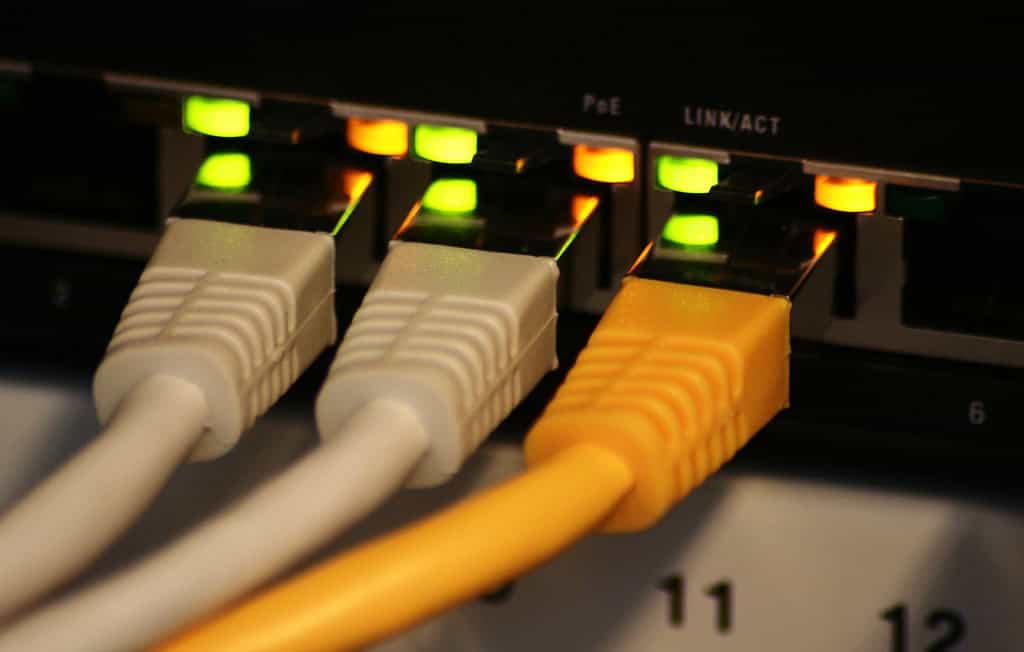
A Local Area Network (LAN) connects computers and devices within a limited area like a home, office, or school. A LAN enables devices to share resources and communicate efficiently. Whether through Ethernet cables or Wi-Fi, LANs are foundational to modern digital infrastructure.
LANs use key devices like routers and switches to manage connections. These devices ensure that data travels swiftly between computers, printers, and other networked hardware. By understanding the basics of local area networks, you can optimize network design and infrastructure for better performance.
Understanding Local Area Networks (LANs)
What is a LAN?
A LAN is a group of computers and devices linked together within a small area, like a home, office, or school. This connection lets them share resources, such as files, printers, and internet access.
How does a LAN work?
LANs use either Ethernet cables or Wi-Fi to connect devices. Ethernet provides faster and more reliable connections, while Wi-Fi offers flexibility and convenience.
Key Components of a LAN
- Nodes: These are the devices connected to the LAN, such as computers, smartphones, printers, and servers.
- Switches: Switches act as central hubs, connecting multiple nodes and directing data traffic.
- Routers: Routers connect the LAN to the wider internet, allowing devices to communicate with the outside world.
- Cables: Ethernet cables are used for wired connections, while Wi-Fi signals are used for wireless connections.
Types of LANs
There are several types of LANs, each with its own advantages and disadvantages:
- Client-Server LAN: A central server manages resources and provides services to client devices. This type of LAN is common in businesses.
- Peer-to-Peer LAN: Devices share resources directly with each other, without a central server. This is often used in small homes or offices.
- Wireless LAN (WLAN): This type of LAN uses Wi-Fi to connect devices, providing more flexibility and mobility.
Advantages of LANs
- Resource Sharing: LANs allow devices to share files, printers, and internet access, saving money and increasing efficiency.
- Communication: LANs make it easy for users to communicate with each other, whether through email, instant messaging, or video conferencing.
- Security: LANs can be secured with firewalls and other measures to protect data and prevent unauthorized access.
- Centralized Management: LANs can be managed from a central location, making it easier to install software, update configurations, and troubleshoot problems.
LAN Topologies
LANs can be arranged in different topologies, which describe how the devices are physically or logically connected.
- Bus Topology: All devices are connected to a single cable, called a bus. This topology is simple but can be prone to congestion.
- Ring Topology: Devices are connected in a circular chain, with each device connected to two others. This topology is less prone to congestion but can be disrupted if a single cable fails.
- Star Topology: All devices are connected to a central switch or hub. This topology is the most common and offers good performance and scalability.
- Mesh Topology: Devices are connected to each other in a redundant fashion, providing high reliability but also increasing complexity and cost.
Table: LAN Technologies and Speeds
| Technology | Speed (Mbps) | Notes |
|---|---|---|
| Ethernet | 10/100/1000/10000 | The most common wired LAN technology, with various speeds available. |
| Wi-Fi 4 (802.11n) | Up to 600 | Older Wi-Fi standard, still widely used. |
| Wi-Fi 5 (802.11ac) | Up to 1300 | Faster than Wi-Fi 4, supports multiple antennas. |
| Wi-Fi 6 (802.11ax) | Up to 9600 | Newest Wi-Fi standard, with improved speed, capacity, and efficiency. |
Key Takeaways
- A LAN connects devices in a small area.
- LANs use routers and switches for efficient communication.
- Understanding LANs helps enhance network performance.
LAN Fundamentals and Topologies
A Local Area Network (LAN) connects computers and devices in a limited area such as a home, school, or office building. It allows for the efficient sharing of resources like files and printers.
Defining LANs
A LAN is a type of computer network that covers a small geographic area. It connects devices such as computers, printers, and servers within a building or group of buildings. Ethernet is a common technology used in LANs for wired connections. It employs Ethernet cables and protocols to ensure data is sent and received correctly. Wi-Fi, on the other hand, uses radio waves to connect devices wirelessly. LANs offer high data transfer rates, usually ranging from 10 Mbps to 10 Gbps. This makes them ideal for rapid data exchange in small areas.
Common LAN Topologies
Network topology refers to the arrangement of different elements (links, nodes) in a computer network. The most common LAN topologies include star, ring, bus, and mesh.
- Star topology: A central hub connects all network devices. Each device has a dedicated cable to the hub. If one link fails, others remain unaffected.
- Ring topology: Devices form a circular pathway. Each device connects to two others. Data travels in one direction between devices.
- Bus topology: All devices share a single communication line. Data packets are broadcasted. Only the intended device accepts and processes the data.
- Mesh topology: Each device connects to multiple other devices. It provides high redundancy and reliability but can be complex and costly to maintain.
Wired vs. Wireless LANs
Wired LANs use Ethernet cables to connect devices. They offer faster data transfer speeds and more secure connections. Ethernet cables require more infrastructure, such as switches and routers. Installing this hardware can be more time-consuming.
Wireless LANs (WLANs) rely on Wi-Fi technology. They use radio waves to connect devices without cables. WLANs provide flexibility and ease of installation. They are ideal for environments where wiring can be difficult. The downside is that they may have lower data transfer rates and can be less secure without proper encryption methods.
Both wired and wireless LANs serve different needs. Wired LANs are preferable for environments needing high speed and security, while wireless LANs offer convenience and mobility.
Network Design and Infrastructure
Effective network design ensures smooth and secure data flow within Local Area Networks. Key elements include selecting the right hardware, managing addressing and routing, and integrating LANs with broader networks like WANs and MANs.
Network Hardware
Network hardware forms the backbone of a LAN. Components include routers, switches, modems, access points, NICs, and cables. Routers direct data between networks, while switches connect devices within the LAN, ensuring data reaches the right destination. Access points allow wireless devices to join the network.
Modems connect the LAN to the internet via the ISP. Using reliable cables like Ethernet ensures fast and steady connections. Firewalls protect the network from unauthorized access. Load balancers distribute network traffic to avoid congestion, maintaining efficiency.
Addressing and Routing
Managing IP addresses and routing is vital for network efficiency. IP addresses identify devices, ensuring they communicate correctly. Dynamic Host Configuration Protocol (DHCP) automates IP assignment, reducing manual configuration work.
Routers use the TCP/IP protocol to direct traffic. VLANs (Virtual Local Area Networks) segment larger networks into smaller parts, enhancing security and performance. Gateways link LANs with other networks like the internet, directing traffic between different protocols. Effective addressing and routing prevent network slowdowns.
LAN, WAN, and MAN Interconnectivity
Interconnectivity extends network reach. LANs cover small regions like offices; WANs (Wide Area Networks) span larger areas, connecting multiple LANs over long distances. MANs (Metropolitan Area Networks) cover cities, larger than LANs but smaller than WANs.
ISPs provide the physical and logical connections for WANs and MANs. Integration involves using routers and gateways to link different network types, ensuring seamless communication. Bridges can connect different LAN segments within a WAN or MAN, enhancing data flow and resource sharing.
Frequently Asked Questions
LANs, or Local Area Networks, are essential in connecting devices within a specific area, such as an office or home. Here, we will address key questions to help understand various aspects such as differences from other networks, their uses, and their impact on performance.
How do LANs differ from WANs in practical applications?
LANs are used in smaller areas like homes or single buildings. They connect devices closely located for resource sharing. WANs, or Wide Area Networks, cover larger areas, such as cities or countries, linking multiple LANs together. This allows devices over long distances to communicate.
What defines a Metropolitan Area Network compared to a Local Area Network?
A Metropolitan Area Network (MAN) spans a larger area than a LAN but smaller than a WAN, typically covering a city or large campus. It connects multiple LANs within this area, facilitating communication across different locations in the same metro region.
In what ways can Personal Area Networks interconnect with Local Area Networks?
Personal Area Networks (PANs) are very short-range networks, like those using Bluetooth. They can connect to a LAN via routers or access points. This lets personal devices, such as smartphones, communicate with other devices on the LAN.
What are the primary uses and benefits of Local Area Networks for organizations?
LANs allow organizations to share resources such as files, printers, and internet connections efficiently. They provide faster data transfer rates within the network’s limited area, enhancing productivity and collaboration.
How does LAN architecture support computer network infrastructure?
LAN architecture includes devices like routers, switches, and Ethernet cables or Wi-Fi access points. These components enable the seamless transfer of data between connected devices, maintaining robust communication within the network.
How is network performance affected by LAN configurations?
LAN performance can be impacted by factors such as the number of devices, the type of cabling used, and network traffic. Proper configuration, like ensuring adequate bandwidth and minimizing interference in wireless networks, helps maintain optimal performance.

